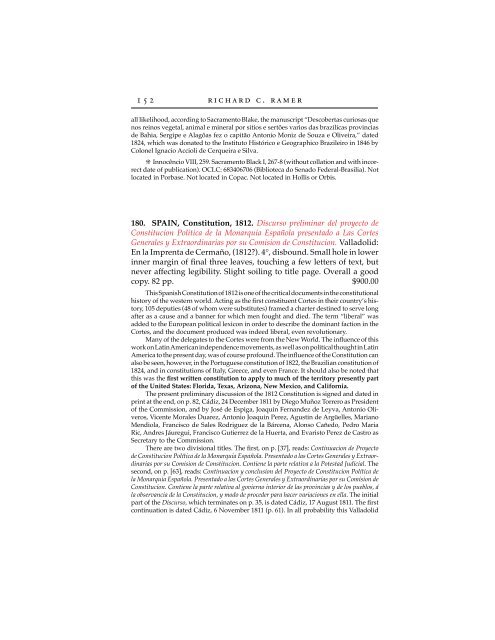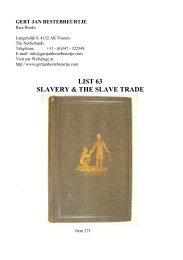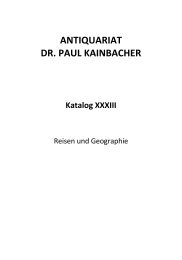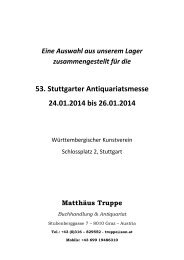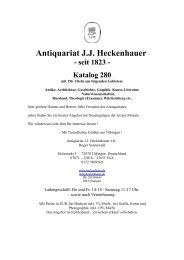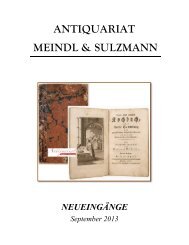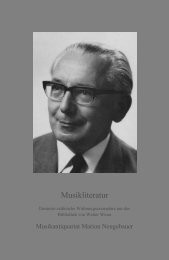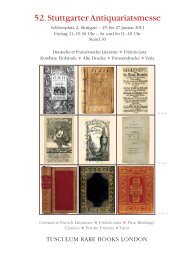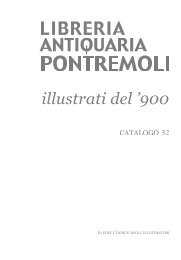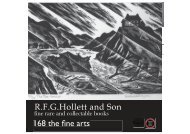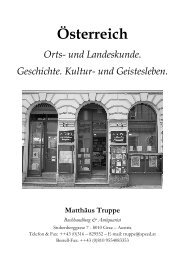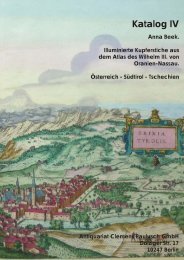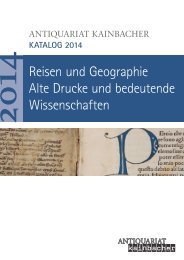Recent Acquisitions - Richard C. Ramer Old & Rare Books
Recent Acquisitions - Richard C. Ramer Old & Rare Books
Recent Acquisitions - Richard C. Ramer Old & Rare Books
You also want an ePaper? Increase the reach of your titles
YUMPU automatically turns print PDFs into web optimized ePapers that Google loves.
152<br />
richard c. ramer<br />
all likelihood, according to Sacramento Blake, the manuscript “Descobertas curiosas que<br />
nos reinos vegetal, animal e mineral por sitios e sertões varios das brazilicas provincias<br />
de Bahia, Sergipe e Alagôas fez o capitão Antonio Moniz de Souza e Oliveira,” dated<br />
1824, which was donated to the Instituto Histórico e Geographico Brazileiro in 1846 by<br />
Colonel Ignacio Accioli de Cerqueira e Silva.<br />
j Innocêncio VIII, 259. Sacramento Black I, 267-8 (without collation and with incorrect<br />
date of publication). OCLC: 683406706 (Biblioteca do Senado Federal-Brasilia). Not<br />
located in Porbase. Not located in Copac. Not located in Hollis or Orbis.<br />
180. SPAIN, Constitution, 1812. Discurso preliminar del proyecto de<br />
Constitucion Politica de la Monarquia Española presentado a Las Cortes<br />
Generales y Extraordinarias por su Comision de Constitucion. Valladolid:<br />
En la Imprenta de Cermaño, (1812?). 4°, disbound. Small hole in lower<br />
inner margin of final three leaves, touching a few letters of text, but<br />
never affecting legibility. Slight soiling to title page. Overall a good<br />
copy. 82 pp. $900.00<br />
This Spanish Constitution of 1812 is one of the critical documents in the constitutional<br />
history of the western world. Acting as the first constituent Cortes in their country’s history,<br />
105 deputies (48 of whom were substitutes) framed a charter destined to serve long<br />
after as a cause and a banner for which men fought and died. The term “liberal” was<br />
added to the European political lexicon in order to describe the dominant faction in the<br />
Cortes, and the document produced was indeed liberal, even revolutionary.<br />
Many of the delegates to the Cortes were from the New World. The influence of this<br />
work on Latin American independence movements, as well as on political thought in Latin<br />
America to the present day, was of course profound. The influence of the Constitution can<br />
also be seen, however, in the Portuguese constitution of 1822, the Brazilian constitution of<br />
1824, and in constitutions of Italy, Greece, and even France. It should also be noted that<br />
this was the first written constitution to apply to much of the territory presently part<br />
of the United States: Florida, Texas, Arizona, New Mexico, and California.<br />
The present preliminary discussion of the 1812 Constitution is signed and dated in<br />
print at the end, on p. 82, Cádiz, 24 December 1811 by Diego Muñoz Torrero as President<br />
of the Commission, and by José de Espiga, Joaquin Fernandez de Leyva, Antonio Oliveros,<br />
Vicente Morales Duarez, Antonio Joaquin Perez, Agustin de Argüelles, Mariano<br />
Mendiola, Francisco de Sales Rodriguez de la Bárcena, Alonso Cañedo, Pedro Maria<br />
Ric, Andres Jáuregui, Francisco Gutierrez de la Huerta, and Evaristo Perez de Castro as<br />
Secretary to the Commission.<br />
There are two divisional titles. The first, on p. [37], reads: Continuacion de Proyecto<br />
de Constitucion Política de la Monarquia Española. Presentado a las Cortes Generales y Extraordinarias<br />
por su Comision de Constitucion. Contiene la parte relativa a la Potestad Judicial. The<br />
second, on p. [63], reads: Continuacion y conclusion del Proyecto de Constitucion Política de<br />
la Monarquia Española. Presentado a las Cortes Generales y Extraordinarias por su Comision de<br />
Constitucion. Contiene la parte relativa al govierno interior de las provincias y de los pueblos, á<br />
la observancia de la Constitucion, y modo de proceder para hacer variaciones en ella. The initial<br />
part of the Discurso, which terminates on p. 35, is dated Cádiz, 17 August 1811. The first<br />
continuation is dated Cádiz, 6 November 1811 (p. 61). In all probability this Valladolid


